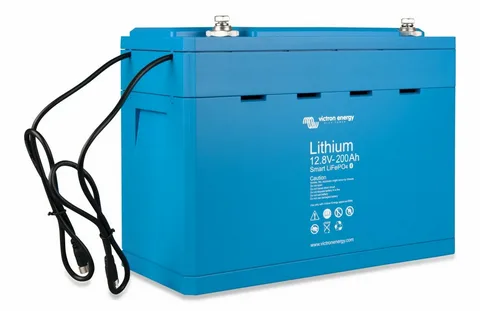When it comes to power solutions, the demand for efficiency is at an all-time high. Enter the Slim Line Lithium Battery—a game changer in energy storage design that combines compactness with exceptional performance. As technology evolves, so do our needs for reliable and efficient power sources. Whether you’re powering a boat, RV, or any off-grid application, these batteries offer remarkable advantages over traditional options.
What Makes Slim-Line Lithium Batteries Efficient?
Slim-Line Lithium Batteries stand out for their advanced chemistry and design. Their energy density is significantly higher than traditional batteries. This means they can store more power in a smaller space. The lightweight nature of these batteries contributes to their efficiency. Less weight translates into reduced energy consumption, especially in mobile applications like electric vehicles or portable devices.
Additionally, the built-in battery management systems optimize performance. These systems monitor charge levels and temperature, ensuring maximum output without compromising safety. Fast charging capabilities enhance usability as well. Users can recharge quickly, making slim-line options ideal for those on the go. Lower self-discharge rates also play a critical role in maintaining efficiency over time. This feature ensures that stored energy remains available when needed most.
Efficiency Benefits of Slimline Lithium Battery 100ah
The Slimline Lithium Battery 100ah stands out for its remarkable efficiency. Its lightweight design allows for easy transport and installation, making it a favorite among outdoor enthusiasts. This battery’s energy density means you can get more power from a smaller package. It delivers consistent voltage over its discharge cycle, ensuring that your devices run optimally without unexpected drops in performance. Another key benefit is the fast charging capability. Users appreciate how quickly they can recharge these batteries, cutting down on downtime significantly.
A long cycle life also contributes to overall cost-effectiveness. Fewer replacements mean lower long-term expenses while maintaining top-notch performance across various applications. Whether you’re powering an RV or supporting renewable energy systems, the Slim-Line Lithium Battery 100ah efficiently meets diverse needs without compromising quality or reliability.
Space-Saving Design: Ideal Applications
Slim-line lithium batteries come with a sleek and compact design that sets them apart from traditional options. Their reduced footprint makes them perfect for environments where space is at a premium. Applications in recreational vehicles are particularly notable. With limited room available, these batteries provide the power needed without taking up unnecessary space. Marine applications also benefit significantly from their slim profile. Boat owners can enjoy reliable energy storage while maximizing deck space.
In addition, the growing trend of tiny homes has created an ideal market for slim-line batteries. These homes prioritize efficiency and minimalism, making every inch count. Even in home backup systems, their design allows easy integration into tight spaces or closets, ensuring homeowners aren’t sacrificing aesthetics for functionality. The versatility of slim-line lithium batteries truly shines across various sectors, reflecting innovation in energy solutions.
Comparison With Traditional Lithium Batteries
When comparing slim-line lithium batteries to traditional lithium options, several key differences emerge. Slim-line designs offer a more compact form factor without sacrificing performance. This makes them particularly appealing for applications where space is limited. Traditional lithium batteries often come with bulkier dimensions, making installation in tight spaces challenging. The slim-line variant easily fits into tighter compartments, providing flexibility in design and layout.
Another significant distinction lies in weight. Slim-line models are typically lighter than their traditional counterparts, enhancing portability and ease of handling. This can be crucial for mobile applications or setups requiring frequent relocation. Efficiency also plays a role in this comparison. Slim-line lithium batteries utilize advanced technology that optimizes discharge rates and charging times, often outperforming older models under similar conditions. Considering these factors helps users make informed decisions based on specific needs and constraints while evaluating battery solutions for various projects or devices.
Factors Affecting the Efficiency of Slim-Line Lithium Batteries
Several variables influence the efficiency of Slim-Line Lithium Batteries. Temperature is a significant factor; extreme heat or cold can impair performance. Operating at optimal ambient temperatures ensures better energy retention and discharge rates.
Temperature Variations
Lithium-ion batteries, including slim-line models, are sensitive to temperature extremes. High temperatures can accelerate degradation and reduce efficiency, while low temperatures can hinder electrochemical reactions and decrease power output. Maintaining a stable, moderate operating temperature is crucial.
Charging and Discharging Rates (C-Rate)
The rate at which a slim-line lithium battery is charged or discharged significantly impacts its efficiency. High C-rates can generate excessive heat, leading to energy loss and reduced lifespan. Optimal charging and discharging within the manufacturer’s recommended C-rate range is essential for maximizing efficiency.
Battery Management System (BMS) Quality
The BMS plays a critical role in monitoring and controlling the battery’s performance. A well-designed BMS with accurate voltage and temperature monitoring, cell balancing, and overcharge/discharge protection ensures optimal efficiency and safety. Inadequate BMS functionality can lead to energy loss and reduced lifespan.
Internal Resistance and Age
Over time, the internal resistance of a slim-line lithium battery increases, leading to energy loss and reduced efficiency. This is a natural aging process, but factors like high operating temperatures and frequent deep discharges can accelerate it. Minimizing internal resistance through proper charging and discharging practices helps maintain efficiency.
How To Properly Store and Maintain 100ah Slimline Lithium Battery
Storing and maintaining a 100ah Slimline Lithium Battery requires careful attention. First, ensure that the battery is fully charged before long-term storage. This helps preserve its lifespan. Keep the battery in a cool, dry place away from direct sunlight. Extreme temperatures can degrade performance over time. Aim for a temperature range between 32°F to 77°F (0°C to 25°C) for optimal conditions.
Regularly check the battery’s voltage every few months. If it drops below recommended levels, recharge it immediately to prevent deep discharge damage. During maintenance, clean any corrosion from terminals with a mixture of baking soda and water. Ensure all connections are secure but avoid overtightening as this may cause damage. Using a smart charger designed specifically for lithium batteries can make charging more efficient while protecting their integrity during the process.
Performance Comparison: Slim-Line Vs. Traditional Lithium Batteries
When comparing slim-line and traditional lithium batteries, performance stands out as a key differentiator. Slim-line models often boast higher energy density, allowing them to store more power in a compact design. Traditional lithium batteries can be bulkier and heavier, which impacts their application versatility. The lightweight nature of slim-lines makes them ideal for portable devices or space-constrained environments.
Charging speeds also vary significantly. Many users find that slim-line options recharge faster, enhancing usability in demanding situations. Moreover, they tend to maintain voltage better under load, providing consistent performance during operation. Lifespan is another essential factor; slim-line batteries often feature advanced management systems that promote longevity compared to older counterparts. This means less frequent replacements and reduced environmental impact over time. The choice between these two types hinges on specific needs—whether it’s weight considerations or storage capacity driving your decision-making process.
Key Factors Affecting Battery Efficiency
Battery efficiency hinges on several key factors. Temperature plays a significant role; extreme cold or heat can drastically reduce performance. Maintaining an optimal operating range is essential for longevity. Another critical aspect is the depth of discharge. Regularly draining a battery to its limits can shorten its lifespan and diminish efficiency over time. A more measured approach helps preserve capacity.
Charging habits also matter greatly. Using high-quality chargers designed for specific battery types ensures proper voltage levels, preventing damage and inefficiencies during charging cycles. Age cannot be overlooked. As batteries age, their chemical composition changes, leading to reduced efficiency regardless of other conditions. Keeping these factors in mind enhances the overall performance of slim-line lithium batteries significantly.
Temperature
The temperature at which a battery operates greatly impacts its efficiency. Extreme cold can hinder the flow of electrons and reduce the battery’s ability to deliver power, while extreme heat can cause damage to the battery’s internal components.
Depth of Discharge
A battery’s efficiency is also affected by how deeply it is discharged during use. Regularly draining a battery to its limits can shorten its lifespan and diminish overall performance. A more measured approach, such as only discharging a battery to 50% or less of its capacity, can help preserve its capacity and prolong its life.
Charging Habits
Using high-quality chargers designed for specific battery types is crucial for maintaining efficiency. Improper charging voltage levels can damage the battery and lead to inefficiencies during charging cycles.
Type of Battery
Different types of batteries have varying levels of efficiency. Lithium-ion batteries are currently considered one of the most efficient options on the market, with slim-line lithium batteries being even more efficient due to their smaller size and
Installation And Compatibility Considerations
When considering the installation of a Slim-Line Lithium Battery, compatibility is key. These batteries are designed to fit snugly in various applications without sacrificing performance. Before installation, assess your space requirements. Slim-line designs can enhance usability where traditional batteries may not fit. Check voltage and capacity specifications to ensure they align with your system.
Wiring configurations also play an important role. Ensure that connectors match your existing setup for seamless integration. This avoids unnecessary complications during installation. Always refer to manufacturer guidelines for mounting options and safety precautions. Proper ventilation is often overlooked but essential for optimal battery operation. Consider inverter compatibility if you’re using these batteries in solar or backup systems. Choosing the right components will help optimize efficiency and prolong lifespan.
Maintenance Tips for Optimal Efficiency
To keep your Slim-Line Lithium Battery performing at its best, regular maintenance is key. Start with periodic inspections to check for any signs of wear or damage. Look closely at the terminals and connections; they should be clean and secure. Temperature plays a significant role in battery health. Aim to store your battery in a cool, dry place away from extreme temperatures. This simple step can extend its lifespan significantly.
Consider using a smart charger designed specifically for lithium batteries. It helps manage charging cycles efficiently, preventing overcharging that could lead to decreased performance. Monitoring the state of charge regularly ensures you’re not draining the battery too low, which can impact longevity. Keeping an eye on these aspects will help maintain optimal efficiency and reliability over time without much hassle.
Conclusion
The efficiency of Slim Line Lithium Battery truly sets them apart in the market. Their space-saving design maximizes usability while ensuring optimal performance. With benefits that extend beyond mere size, these batteries offer a robust solution for various applications. From recreational vehicles to renewable energy systems, their adaptability shines through. Regular maintenance and proper storage can significantly enhance longevity, making them an investment worth considering.
FAQs
What is a Slim Line Lithium Battery?
A Slim Line Lithium Battery is designed with a compact and lightweight profile while maintaining high energy density. This makes it particularly suitable for space-constrained environments without compromising performance.
How long do slim-line lithium batteries last?
The lifespan varies based on usage and maintenance but typically ranges from 8 to 15 years. With proper care, such as avoiding complete discharges and storing at optimal temperatures, you can maximize their longevity.
Can I use a slim-line lithium battery in my solar setup?
Absolutely! Slim-line lithium batteries are great options for solar applications due to their efficient charging capabilities and ability to handle deep discharge cycles effectively.
Are there safety concerns with using slim-line lithium batteries?
While they are generally safe when used correctly, it’s crucial to follow manufacturer guidelines regarding installation and maintenance. Proper handling reduces risks associated with overheating or short circuits.
| Related Business Listings |
| Contact Directory |
| Local Business Profiles |




